G
How useful is this
The charge sheath vortex develops within a large charge cloud where
the repulsion between the charges is cancelled out,
1 ) Two stationary particles carrying the same electrical charge will
repel each other, but within an electric field they will form dipoles
that will experience an attractive force.
2 ) In a large charge cloud where the repulsion between the charges is
the same in all directions, this force will cancel out
3 ) Two streams of dipoles with the same field charge moving
in parallel in a large charge cloud will also develop a force of attraction
through their electromagnetic interaction.
4) An electron cascade of electrons briefly following a free path through
the magnetic field will briefly travel at very much higher velocities and
contribute to a greatly intensified electromagnetic field.
By a quirk of history, diagrams of electrical current show the arrow
for current direction for the movement of positive charge. This makes
no difference for the charge sheath, but can be a little confusing for
students of electricity at first.
The arrow on field lines is shown pointing to the south magnetic
pole. The direction shown by a compass.
The north pole on a magnetic compass points to a south magnetic
pole -(At the geographic north pole!)
Some of the following images come from the hyperphysics
site.
This shows the magnetic field produced by a positive charge particle
moving. Note the way the thumb placed in the direction of movement and
the fingers showing the magnetic field.
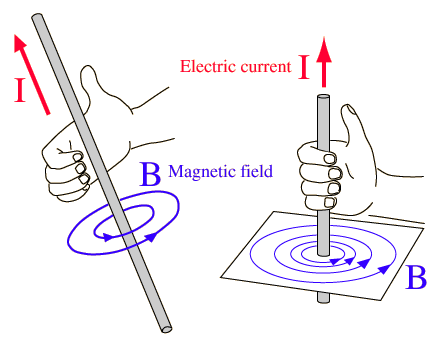
If several charged particles move in parallel, the magnetic forces
between them draw them together.
We know from Z pinch experiments that the electromagnetic forces
that draw the particles togther is greater than the electrostatic charge
that pushes them apart.
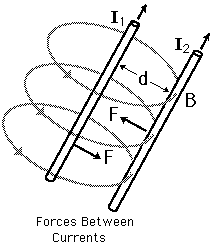
When a moving charge passes through a magnetic field it experiences
a force which is perpendicular to both the magnetic field and the velocity.
- shown by the red dotted line in the following diagram. As the particle
responds to the force, by moving upwards, the force continues to act perpendicular
to the new path, and so the particle will be forced into a circular path
if it remains within the magnetic field..
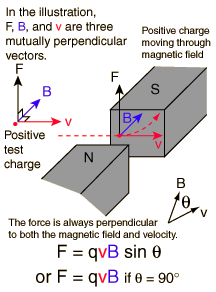
But the moving charge particle also produces a magnetic field. Note
that the direction of the magnetic field produced by the charge particle
(arrows point to the south pole) is the opposite direction
in relation to the circular path of the charged particle as
in the diagram above. The charge particles are therefore cancelling the
magnetic field which caused the charge particle to follow a circular
path.
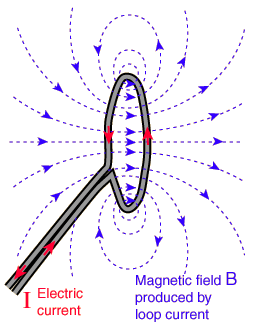
This would seem to indicate that a plasma stream should not
produce a self confining vortex. But it is not this force that is at work
in the charge sheath vortex. The charge particles are not turning in response
to moving through an external magnetic field!
The charge sheath vortex develops within a large charge cloud where
the repulsion between the charges is cancelled out,
1 ) Two stationary particles carrying the same electrical charge will
repel each other, but within an electric field they will form dipoles
that will experience an attractive force.
2 ) In a large charge cloud where the repulsion between the charges is
the same in all directions, this force will cancel out
3 ) Two streams of dipoles with the same field charge moving
in parallel in a large charge cloud will also develop a force of attraction
through their electromagnetic interaction.
4) This can develop into an electron cascade where fast moving free electrons
briefly follow the circular path round the vortex and greatly increase the
magnetic field strength of the vortex.
Consider the case where a fast moving stream of positive particles
forms a loop in the absence of an externally applied magnetic field.
There is a powerful force of attraction between the particles moving in
parallel as in B above.
If a charged particle strays inwards into the inner field, the magnetic
force on the charged particle will subject the particle to a force
that pushes it back out into the sheath as discussed in C and D above. If
the charged particle strays outwards into a region where the field is in
the opposite direction, the force it is subject to will push it back into
the sheath.
Note that the charge particles have to be very fast moving in order to sustain
this vortex. At lower speeds the charge repulsion will be greater than the
electromagnetic attraction, unless the vortex forms in a small region of
a larger uniform charge cloud.
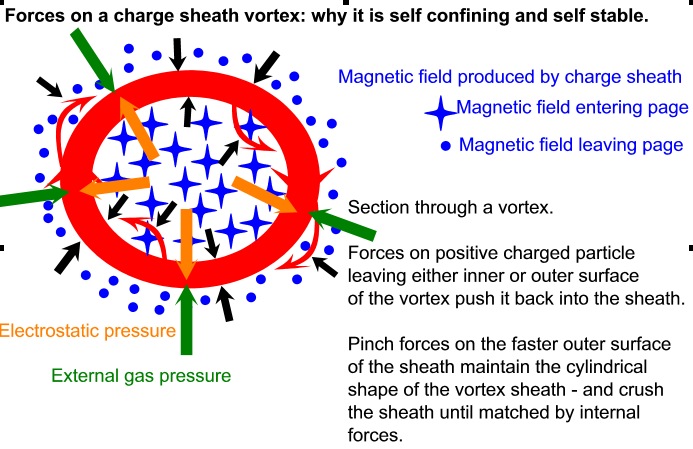
The flow is held as a coherent stream by the attraction between forces
moving in parallel. Any instability in velocity will cause greater magnetic
fields in the faster region than the slower regions.
The faster region with the greater magnetic field will be pinched
more, speeding up the flow, which increases the pinch and so on
becoming longer and thinner. But the extension in length cannot be accommodated
in a straight line. It can only force the stream to form a loop.
The forces between the charge particles within the charge sheath are balanced
by the charge field in the surrounding region in a large cloud, so the force
of repulsion between the charges is zero -only the electromagnetic
field remains. If an electron cascade takes place then the vortex will be
stable even in a small region of plasma.
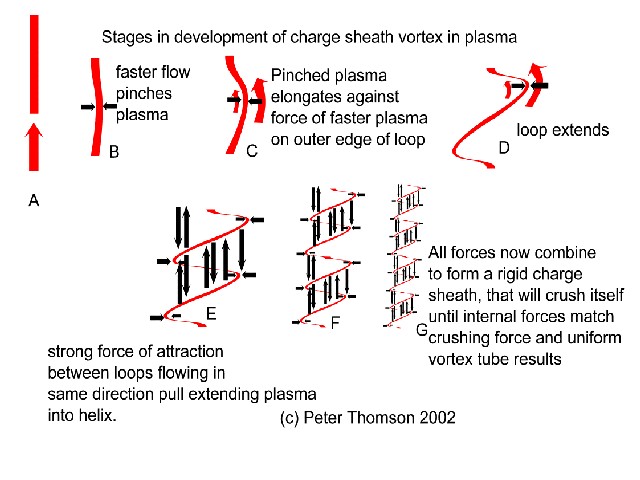
Within a non neutral plasma, if the plasma is travelling in a straight line,
the inwards forces on both sides of the plasma are equal, but if
a kink starts to form, the plasma on the outer surface is travelling faster
than the plasma on the inner surface. The inward force on the outer surface
is therefore greater than the outward force on the inner surface.
The forces due to charge are balanced by the forces in the
surrounding charge cloud.
As soon as a loop establishes itself in a flowing plasma, the force
of attraction between charge flowing in parallel will wind the plasma onto
the end of the coil, producing a long vortex filament.
The outer surface of the vortex filament continues to rotate faster
than the inner surface, so the inward force on the outer surface remains
stronger than the outward force on the inner surface. This ensures that
the plasma, once formed into a vortex will remain in the vortex.
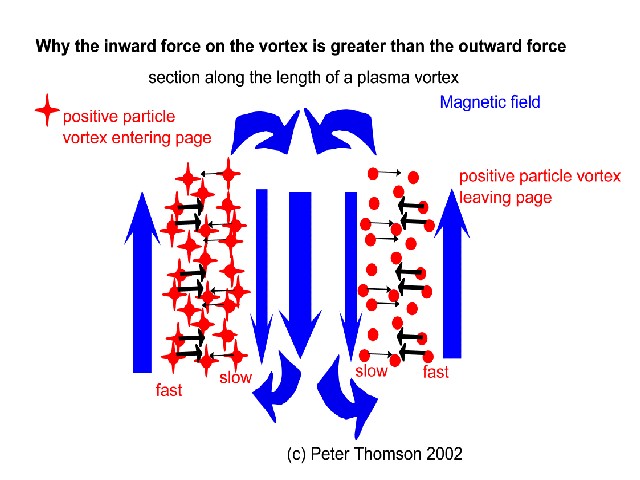
The plasma sheath is compressed between the powerful inward and outward
forces, accelerating and generating yet more powerful forces. Since the
outer force pushing inwards always remains the stronger, the vortex will
compress and narrow- until the forces generated by the opposing sheath
wall spinning in the opposite direction prevent further compression.
The force needed to turn the particles into the curve will
also increase as the velocity increases and radius of curvature increases
and will put a limit on the minimum radius the vortex can achieve.
Within the centre of the charged sheath vortex the fields reinforce
each other to produce a powerful solenoidal field.
The charge sheath vortex develops within a large
charge cloud where the repulsion between the charges is cancelled out,
1 ) Two stationary particles carrying the same electrical charge will
repel each other, but within an electric field they will form dipoles
that will experience an attractive force.
2 ) In a large charge cloud where the repulsion between the charges is
the same in all directions, this force will cancel out
3 ) Two streams of dipoles with the same field charge moving
in parallel in a large charge cloud will also develop a force of attraction
through their electromagnetic interaction.
If there is a significant population of free electrons
within the rotating plasma, then these will move in the direction of rotation
at much greater velocities than the bulk flow of the plasma, and contribute
a very large component to the solenoidal or torroidal electromagnetic fields.
This will make the charge sheath vortex stable even in a small volume of
charged plasma.
When you have studied the pages you are welcome to
join the discussion, but please note that any claims you make for or against
these theories should be backed by scientific reasoning that can be developed
from first principles.
tornado fusion Charge sheath vortex basics for tornado
| ggggghhggfttfyyf |
|
ok i have one question what does shear mean
How useful is this message about tornado fusion Charge sheath vortex basics for tornado? |
Copyright Peter Thomson 2012-March-16
